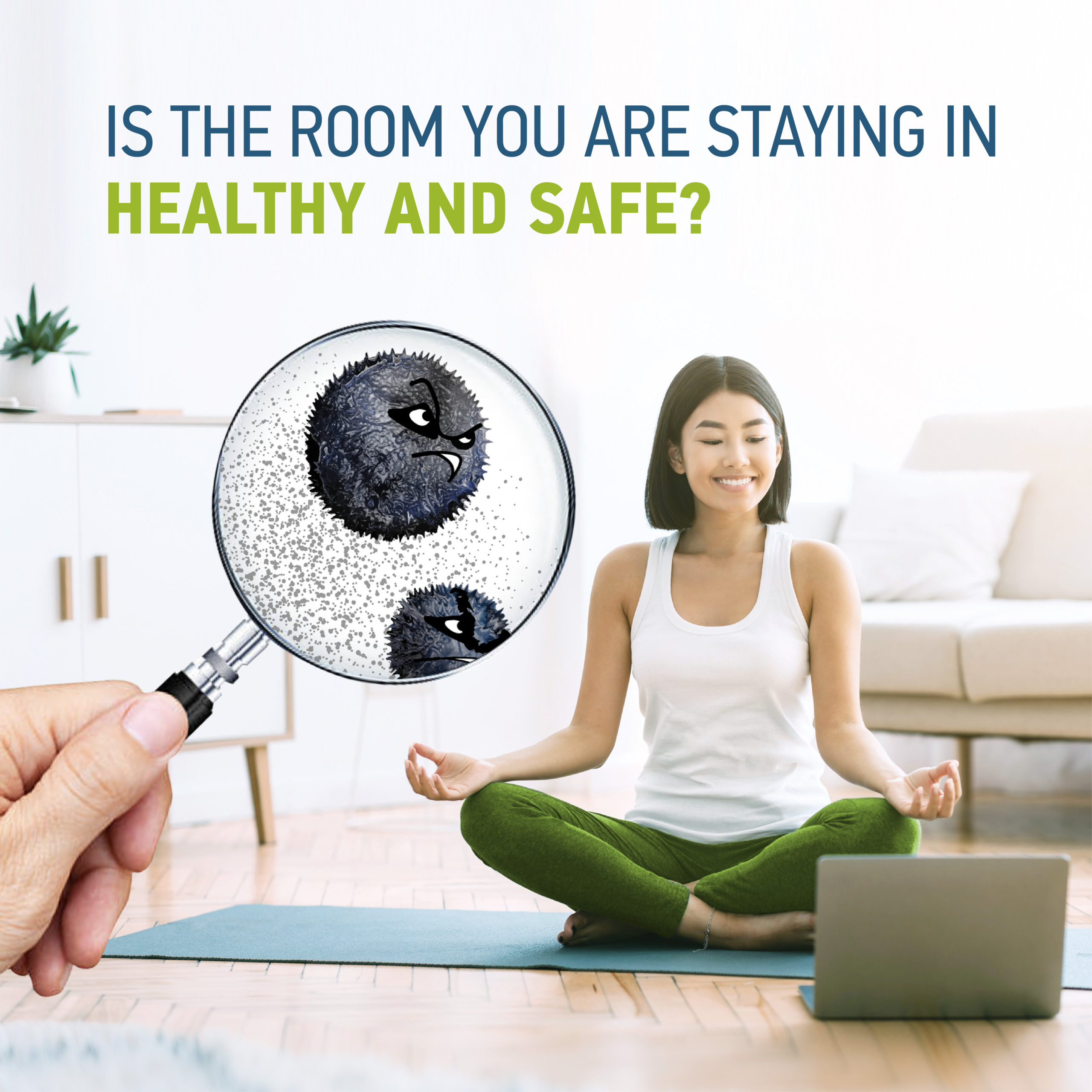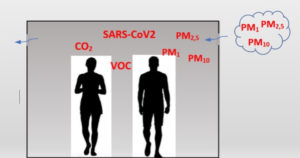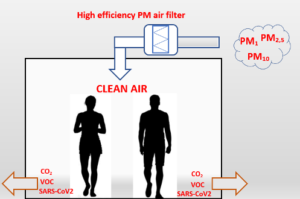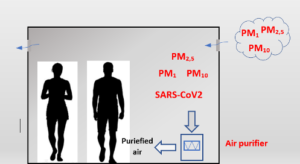
Did you know? The primary source of indoor pollution in public and residential buildings is the people who generate CO2 and other metabolic products. As the COVID-19 pandemic pointed out, viruses or bacteria originating from human respiration impose equal harm on an indoor environment as much as volatile organic compounds (VOCs), building materials and furnishings, and several other sources such as aerosol sprays, cleaners and disinfectants or office equipment. You may not intend to be part of the problem, but you can be part of the solution. Learn about how you can keep your room safe from others and yourself.
On average, we spend 90% of our time indoors. Thus the quality of indoor climate is essential for our wellbeing, health, comfort and productivity. A key parameter for a good climate is Indoor Air Quality (IAQ). However, there are many indoor and outdoor pollutants that deteriorate IAQ, if not removed properly.
The main source of indoor pollution in public and residential buildings is the people themselves, who generate CO2 and other metabolic products. As the COVID-19 pandemic pointed out, viruses or bacteria originating from human respiration are no less important contaminants of the indoor environment.
Very significant indoor pollutants are also Volatile Organic Compounds (VOCs), which are emitted from building materials and furnishings, but also from several other sources such as aerosol sprays, cleaners and disinfectants or office equipment (printers or copiers).
Another key reason for IAQ deterioration is outdoor air pollutants entering interiors in an uncontrolled manner. Besides volatile chemical compounds, these are harmful particulate matter, including smog, fine dust, pollen, bacteria, and moulds, along with other organic and inorganic hazardous particles. This aspect is particularly important where outdoor air quality is poor, which is the case in most urban and industrial areas. All of these contaminants are harmful to human health at prolonged exposure to high concentrations.
If the emitted pollutants are not removed, their concentration in interiors reaches hazardous levels over time (see Figure 1). This applies both to short-term and long-term health effects, as well as the risk of infection. For that reason, ventilation must be applied to remove stale indoor air containing hazardous pollutants and replace it with clean outdoor air. It is now widely recognised that without proper ventilation, even in a typical dwelling, indoor air can be as much as 8 times more polluted than outdoor air. Let alone a densely occupied public building or a crowded restaurant, for instance.

Figure 1: High concentration of pollutants in spaces without or with poor natural ventilation without filtration ©Igor Sikonczyk
There are various ways of exchanging air, including the simplest and traditional, such as window airing or natural ventilation. However, these methods do not meet basic comfort and energy efficiency requirements for modern buildings, nor do they provide adequate and controlled ventilation air volumes to maintain good IAQ.
In practice, the only appropriate and energy-efficient way to provide for necessary air renewal is balanced mechanical ventilation. Modern mechanical supply and exhaust, or in other words, balanced, ventilation systems can effectively exchange stale indoor air with outdoor air in volumes adjusted to the current demand in a fully controlled and automated manner.
In addition to energy, comfort and health issues, another fundamental benefit of mechanical ventilation is the prevention of pollutants from the outdoor air entering the building. As mentioned above, the outdoor air supplied to a building to provide oxygen and replace stale indoor air containing harmful pollutants (CO2, VOCs, etc.) may be polluted. Thus, before it is supplied to occupied spaces, the harmful particles it contains must be removed (see Figure 2). To this end, a proper filtration system for outdoor air is required. Outdoor air may contain high concentrations of fine particles of various sizes. In technical terms these are classified as particulate matter PM10 (particles of diameter < 10 μm), PM2,5 (< 2.5 μm) and PM1 (< 1 μm). You may come across this classification in the daily outdoor air quality reports for your area. Extensive medical studies showed that exposure to air with high PM concentrations can pose serious health risks.The diseases associated with PM contamination include lung cancer1, cardiovascular diseases2, chronic obstructive lung disease3 or allergy and asthma4. The smaller the particle, the more dangerous it is to health. PM1 particles are tiny enough to even enter the blood stream. According to the European Environment Agency (EEA), air pollution is the biggest environmental risk to health in Europe5. One of most harmful pollutants to human health is particulate matter (PM). In 2018, estimates of the health impact of long-term exposure to air pollution in the EU-28, indicated that PM2,5 was responsible for approximately 379.000 premature deaths6.

Figure 2: Removal of indoor pollutants by mechanical ventilation with high efficiency PM filters ©Igor Sikonczyk
Fortunately, a correctly designed filtration system can reduce the concentration of particulate matter, including the smallest PM1, to acceptable levels. This means that even if you are at risk of exposure to high PM pollution outdoors, in buildings with proper filtration and ventilation system, you can benefit from a clean and safe indoor environment.
Filtration may also be used for improving IAQ in spaces where mechanical ventilation does not exist and cannot be installed (e.g. in old buildings). Some pollutants emitted indoors, including pathogens like bacteria or viruses exhaled by infected people or fine particles of tobacco smoke, may be effectively removed by recirculating and filtering indoor air. This can be performed by installing filters in the ductwork of recirculated air by means of stand-alone air cleaners (see Figure 3).

Figure 3: Cleaning indoor air with air purifies in rooms without ventilation or with poor natural ventilation ©Igor Sikonczyk
However, although this solution improves IAQ, it does not solve the problem of fresh air supply and CO2 and VOC removal, which only mechanical ventilation can effectively provide.
___________________________________________
[1] https://thorax.bmj.com/content/75/1/85
[2] https://www.ncbi.nlm.nih.gov/pmc/articles/PMC4740122/
[3] https://pubmed.ncbi.nlm.nih.gov/19554194/
[4] https://www.ncbi.nlm.nih.gov/pmc/articles/PMC6034084/, https://www.sciencedirect.com/science/article/pii/S0954611115001870
[5] https://www.eea.europa.eu/themes/air/air-pollution-is-the-single
[6] Air quality in Europe – 2020, Report 9/20, European Environment Agency, 2020 (EEA, 2020) https://www.eea.europa.eu/publications/air-quality-in-europe-2020-report